Interview by William Kherbek // May 19, 2020
Torbjørn Kvasbø has been producing his richly evocative ceramic works for more than four decades. He is frequently the subject of exhibitions that span from Lillehammer in Norway to China’s Liling Ceramic Valley Museum, but he continues to work from a small village in central Norway called Venabygd. Many writers have drawn parallels with the rugged landscape of the mountainous village and the sculptures Kvasbø creates, but he eschews overly literalist readings of his works, focussing instead on a symbolic heritage and his connections to a rich vein of Norwegian folk culture. Kvasbø spoke to us about the misconceptions that have often grown up around his work, as well as the thematic and formal concerns that have infused his practice from its beginnings. Kvasbø argues for a specificity to his tradition, and describes a radical openness and aleatory dimension in his work that draws influence from his own medium and other artistic forms, including abstract painting.
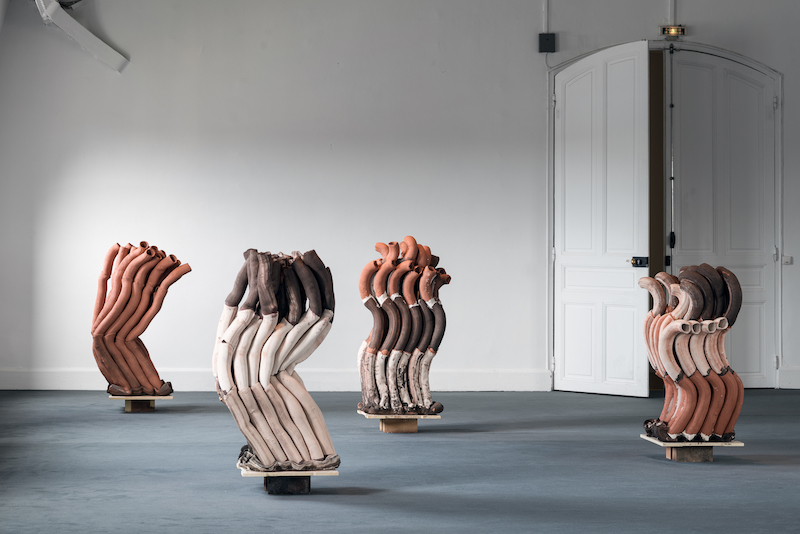
Torbjørn Kvasbø: ‘Tube Sculptures,’ 2018, terracotta, 125 cm height, Sévres // Photo by Andreas Dyrdal
William Kherbek: The two works included in ‘The White, The Green, and The Dark’—’Stack, Tube forms’ (2012) and ‘Trough form’ (1997)—represent a 15 year span between their creation. Could you speak about the ways in which your exploration of form has evolved over that period?
Torbjørn Kvasbø: It clearly shows, in my opinion, that I’m just working on one project all the time. It’s just slowly moving ahead. There’s no real choice; it just kind of happens, you know?
WK: Are there particular interests, concerns or forms that you find yourself returning to?
TK: There are formal themes in my work. There have been chests; there have been coffins; there have been houses; there have been plates, and slabs, and they have kind of slowly replaced each other over a long, long period of time. But the origin, the background for these shapes, is that they’re quite archetypal forms that are very, very typical all over the world, but also in my culture.
I live in a very old culture in this village. I have furniture in my house from 1750 that belonged to my family and these are in very simple shapes, very strong shapes, and they have always had a strong impact for me as I grew up, and I come to understand them. They are always at the base [of my work]. I moved very far away from them, almost as far as I could, but I never lost sight of them. It’s like if you walk in the mountains you always have some reference point somewhere that you never lose sight of, otherwise you’re lost. Working, I still have these reference points so that I can understand and measure the distance I have been walking.
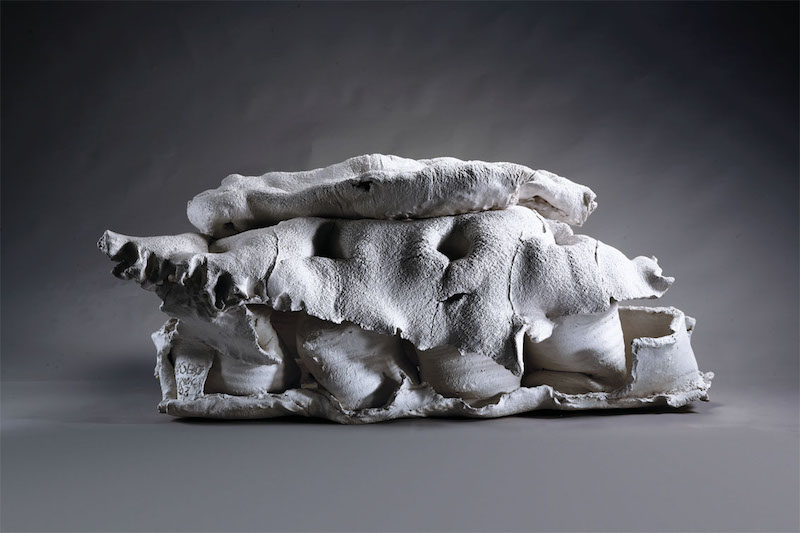
Torbjørn Kvasbø: ‘White form with body,’ private collection, 2003, width 117 cm // Photo IT Park Photographic Studio Ming Chih Hung
WK: Using this metaphor of the natural world, the mountains, I wanted to ask how the natural world features in your work? Given that clay is perhaps the most primordial material, connecting to the earth itself, how much does your work reflect an interest in the environment?
TK: Earlier when art historians wrote about my work they always wrote about volcanoes and eruptions, and about nature, but Gabi Dewald—a German art historian and magazine editor—said this is not accurate. She was the first one who really understood: it is about mental landscapes, inner landscapes. It has nothing to do with nature. Clay is a coincidence. I never grew up with the material. I grew up playing piano, and I started with clay when I was 20 years old. So there is no connection like this, but the material is fascinating, and you soon realise that it is a very time-consuming process. If you really want to understand a material like this, it takes all your time. That is what slowly happened. But it is not about geographical landscape or a map or anything like that. It’s in my head.
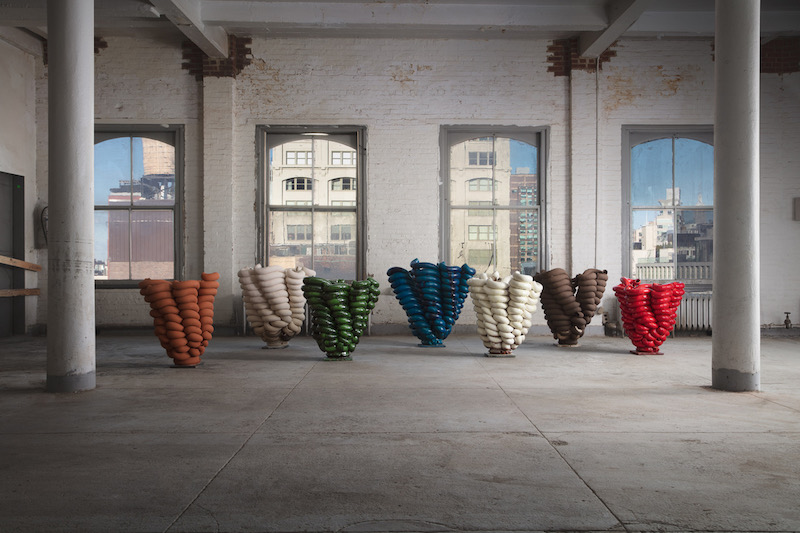
Torbjørn Kvasbø: Collection of ‘Stacks,’ 2019, 100 cm height, Hostler Burrows Gallery, New York // Courtesy of the artist
WK: The tube form is a persistent touchstone in your work. It is a richly metaphoric form in that it both occupies space and contains space, and tubes can be found inside our bodies as well as in the world. What significance does the tube as a form hold for you in your work?
TK: I’ve always been working with the container, the vessel. The vessel is strong in our tradition and the vessel is a metaphor, it’s a practical object that has been very, very important, but it’s also a metaphor for so many things: for the house, for the coffin where you end up, for your skull, for your head. It’s an object that contains a lot of taboos, forbidden thoughts. I don’t define it very clearly, but it’s such a rich object for me.
WK: In the works in ‘The White, The Green, and The Dark,’ burning and sand-blasting are used to create the sculptures on show. Fire is, of course, a central tool of a ceramicist-sculptor’s practice, but I wanted to ask about how you approach firing projects: how much is a matter of chance, and how much derives from a specific formal result you are seeking?
TK: It’s a dialogue. Working with the material, or in a material context, requires a very open dialogue with what is going on in front of your eyes, in between your hands. Accidental or not, it really doesn’t matter. The only control you have actually is to try to be aware of what happened. You can’t really control what is happening, because you’re working outside of control. So the only control element is to try to understand: “this looks interesting” or “this is something I can develop.” It’s always like a fox, following traces of what happens.
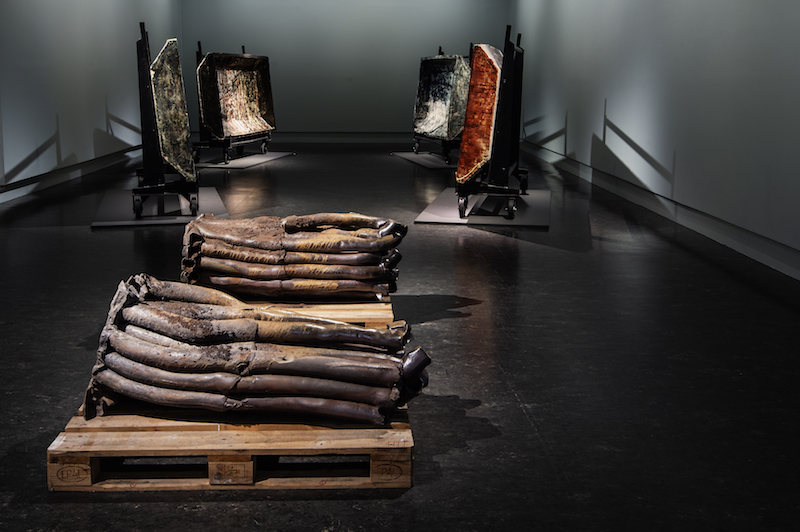
Torbjørn Kvasbø: ‘Horizontal tubes,’ SKMU Norway, 2020, width 125 cm // Photo by Jacob Buchard
WK: Do you see your art as part of any specific historical Scandinavian or Norwegian lineage?
TK: Norway is not really mentally or culturally a part of Scandinavia. It’s very different. It’s been a very homogeneous society. So instead of picking up Scandinavian design and these things, which had such a strong impact in the 50s, 60s and 70s, we revolted against that in Norway, and we did something else. We used our own folk art traditions in all applied arts and material practices, in textiles, in jewellery, in woodwork and in ceramics.
WK: Has working in a place like Venabygd had an impact on the approaches you take or choices you make as an artist? Do you believe it has shaped your thinking in significant ways?
TK: I am from this mountain village. It’s a small village of 300 people. I live in my grandfather’s house. When we established here in the 1970s this was the ideal. You wanted to be your own independent producer. You wanted to have your studio, and you wanted to move out of the cities. You wanted to live an alternative lifestyle. The 70s were very romantic, and most of us after art school did this. Very few people established themselves in the cities. Fine artists did, craftspeople did not. There’s a big difference. There’s no connection whatsoever between traditional fine arts and the crafts. We have different trade unions; we have different needs. We have different traditions and practices, of course, but we work in the same market.
People don’t make a distinction between crafts and art anymore. I exhibit my work in museums, so we do visual art and that’s it. The practical reason for living how I do is that I need space. It’s a space-demanding craft that I am working with, and I need to be able fire and produce smoke and use a chainsaw and all these practical things give me the freedom to do whatever I want [in a way] that I could not do in an urban neighbourhood. So that was the situation for quite a few of us. And we took on the consequences of it. And we stay here. I don’t think it was really a draw back for my own development or career to live like this. I don’t really see how you need to be in a city to be in the market. That all depends on the work.
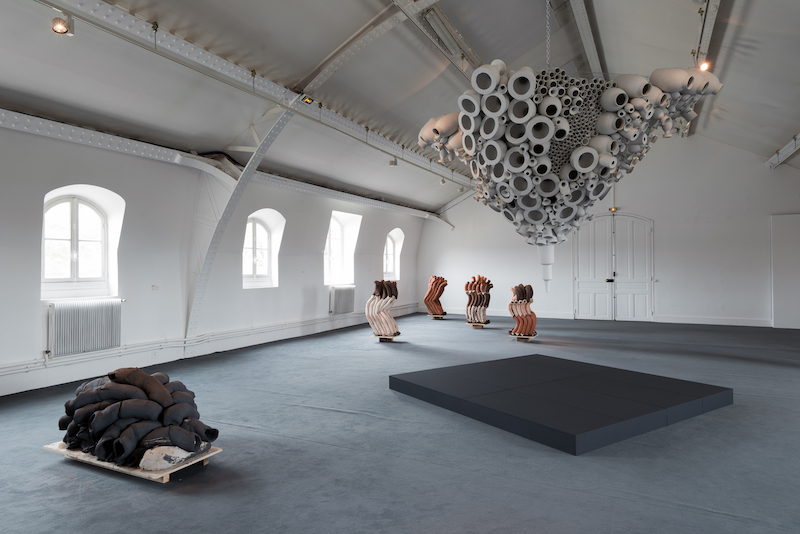
Torbjørn Kvasbø: ‘Cluster of Vases,’ 2018, 450cm diameter, Salle Eiffel Paris, Sévres // Photo by Andreas Dyrdal
This article is a part of our Features’ topic ‘Landscape’ and is presented in collaboration with the Royal Norwegian Embassy in Berlin on the occasion of their exhibition ‘The White, the Green, and the Dark: Contemporary Positions from Norway,’ in which Torbjørn Kvasbø is a participating artist. The exhibition, curated by Sabine Schirdewahn, explores concepts of identity and home through intimate portrayals of the region’s landscape, both ecological and social, using a wide variety of media from sound and film to textile and sculptural works. A further emphasis of the contemporary works on display is the presentation of works by artists who belong to the Indigenous ethnic group of the Sámi. To read more from this topic, click here.
Artist Info
Exhibition Info
ROYAL NORWEGIAN EMBASSY
Group Show: ‘The White, the Green, and the Dark: Contemporary Positions from Norway’
Exhibition: June 02 – Oct. 03, 2020
Fellehus, Nordic Embassies, Rauchstraße 1, 10787 Berlin, click here for map
Upcoming Exhibitions
Oct. 24, 2020: Taoxichuan Art Museum, Jingdezhen China
Feb. 2021: Shanghai Museum of Modern Art, China
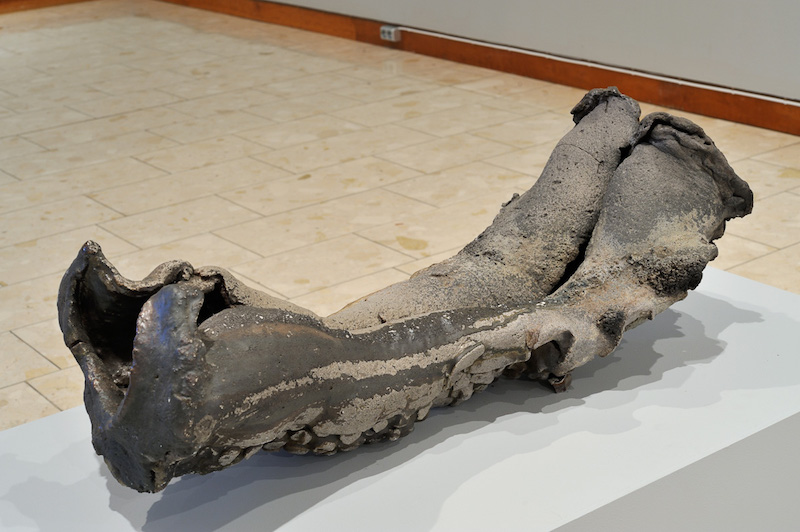
Torbjørn Kvasbø: ‘Trough Form,’ 1997, Iron rich stoneware, stretched plastic slabs, slab built, natural ash glaze and flashing, anagama fired, sand-blasted. L 80 cm, Private collection // Photo: Torbjørn Kvasbø
























